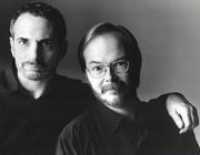FORMED: 1972, Los Angeles, CA DISBANDED: 1981
The seeds of this much-respected rock band were sewn at New York's Bard College where founder members Donald Fagen (b. 10 January 1948, Passaic, New Jersey, New York, USA; keyboards/vocals) and Walter Becker (b. 20 February 1950, Queens, New York, USA; bass/vocals) were students. They subsequently forged a songwriting team and their many demos were later collected on several exploitative compilations. Formative versions of 'Brooklyn', 'Barry Town' and 'Parker's Band' - each of which were re-recorded on official Steely Dan releases - were recorded during this period. The duo also enjoyed a contemporaneous association with pop/harmony act Jay And The Americans, for which they adopted the pseudonyms Gus Marker and Tristan Fabriani. Becker and Fagen appeared on the band's last US Top 20 hit, 'Walkin' In The Rain' (1969), the albums Wax Museum and Capture The Moment, and accompanied the unit on tour.
Vocalist Kenny Vance and drummer John Discepolo joined the pair for You Gotta Walk It Like You Talk It (Or You'll Lose That Beat), the soundtrack to a low-key 1971 movie. Denny Dias (guitar) also contributed to these sessions and he joined Fagen and Becker on their next project which evolved following an alliance with producer Gary Katz. Taking the name 'Steely Dan' from the steam-powered dildo in William Burroughs' novel The Naked Lunch, the trio was quickly expanded by the arrival of David Palmer (b. Plainfield, New Jersey, New York; vocals, ex-Myddle Class), Jeff 'Skunk' Baxter (b. 13 December 1948, Washington DC, USA; guitar, ex- Ultimate Spinach ) and Jim Hodder (b. Boston, Massachusetts, USA, d. 5 June 1990; drums). The accomplished Can't Buy A Thrill was completed within weeks, but drew considerable critical praise for its deft melodies and immaculate musicianship.
The title track and 'Do It Again' reached the US Top 20 when issued as singles and this new-found fame inspired the sarcasm of 'Showbiz Kids' on Countdown To Ecstasy. Their second album was another undoubted classic of the 70s, and featured such bittersweet celebrations as 'The Boston Rag' and 'My Old School'. By this point Palmer had left the line-up following an uncomfortable US tour, but although Baxter declared the set superior to its predecessor, the same commercial approbation did not follow. This was reversed with the release of Pretzel Logic, Steely Dan's first US Top 10 album. Here Fagen and Becker drew more fully on their love of jazz, acquiring the riff of 'Rikki Don't Lose That Number' from Horace Silver 's 'Song Of My Father' and recreating Duke Ellington 's 'East St. Louis Toodle-O'. The former reached number 4 in the US charts.
The band's clarity of purpose and enthralling dexterity was never so apparent, but internal conflicts simmered over a reluctance to tour, shown by Becker and, especially, Fagen who was unhappy with the in-concert role of frontman. Steely Dan's final live appearance was on 4 July 1974 and ensuing strife resulted in the departures of both Baxter and Hodder. The guitarist resurfaced in the Doobie Brothers, with whom he was already guesting, while the drummer reverted to session work. The faithful Dias joined newcomers Michael McDonald (keyboards/vocals) and Jeff Porcaro (drums) for Katy Lied which also featured cameos by guitarist Rick Derringer and saxophonist Phil Woods.
At the time of issue the set was, however, greeted with disquiet as the transformation from active unit to purely studio creation resulted in crafted anonymity. In recent years the album has shown its strengths and is now highly-rated. The Royal Scam redressed the commercial balance and in its title track offered one of the band's most impressive moments to date. Becker and Fagen were, by now, the sole arbiters of Steely Dan, McDonald having followed Baxter into the Doobie Brothers and Dias and Porcaro opting for studio employment. The new collection boasted another series of sumptuous tunes and included 'Haitian Divorce', the group's lone Top 20 hit in Britain. Aja continued in a similar vein where an array of quality musicians - including Wayne Shorter, Jim Horn and Tom Scott - brought meticulousness to a set notable for the seemingly effortless, jazz/disco sweep evinced on 'Peg'.
A similar pattern was unveiled on the immaculately recorded Gaucho, the release of which was marred by conflict between the band and record label over escalating recording costs. The latter's nervousness was assuaged when the album achieved platinum sales and an attendant single, 'Hey Nineteen', reached the US Top 10. However, Becker and Fagen had now tired of their creation and in June 1981 they announced the break-up of their partnership. The following year Fagen released The Nightfly, a superb collection which continued where his erstwhile band had ended. Producer Katz supervised the accustomed cabal of Los Angeles session musicians to create a sound and texture emphasizing the latter's dominant role in later Steely Dan releases. Becker meanwhile produced albums for China Crisis and Rickie Lee Jones, but in May 1990 the pair were reunited in New York's Hit Factory studio to collaborate on material for a forthcoming Fagen project. 'We're not working as Steely Dan,' stated Becker, but aficionados were undoub tedly heartened by news of their rekindled partnership. Although it took a further three years, the partnership worked together on Donald Fagen's impressive Kamakiriad and played live shows as Steely Dan to delighted fans.
Becker released his solo debut, the largely ignored 11 Tracks Of Whack, in 1994. Nothing gels quite like the two working together as Steely Dan, however, and their much vaunted studio reunion Two Against Nature eventually saw the light of day in March 2000.
Source: http://www.chaosmusic.com/shop/biography.asp?artistID=9175.
